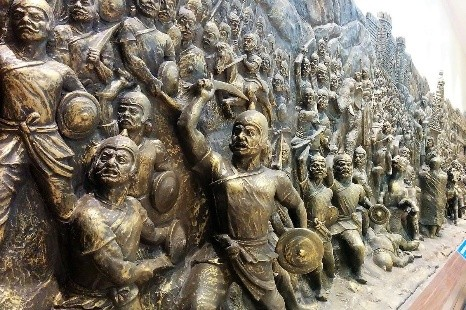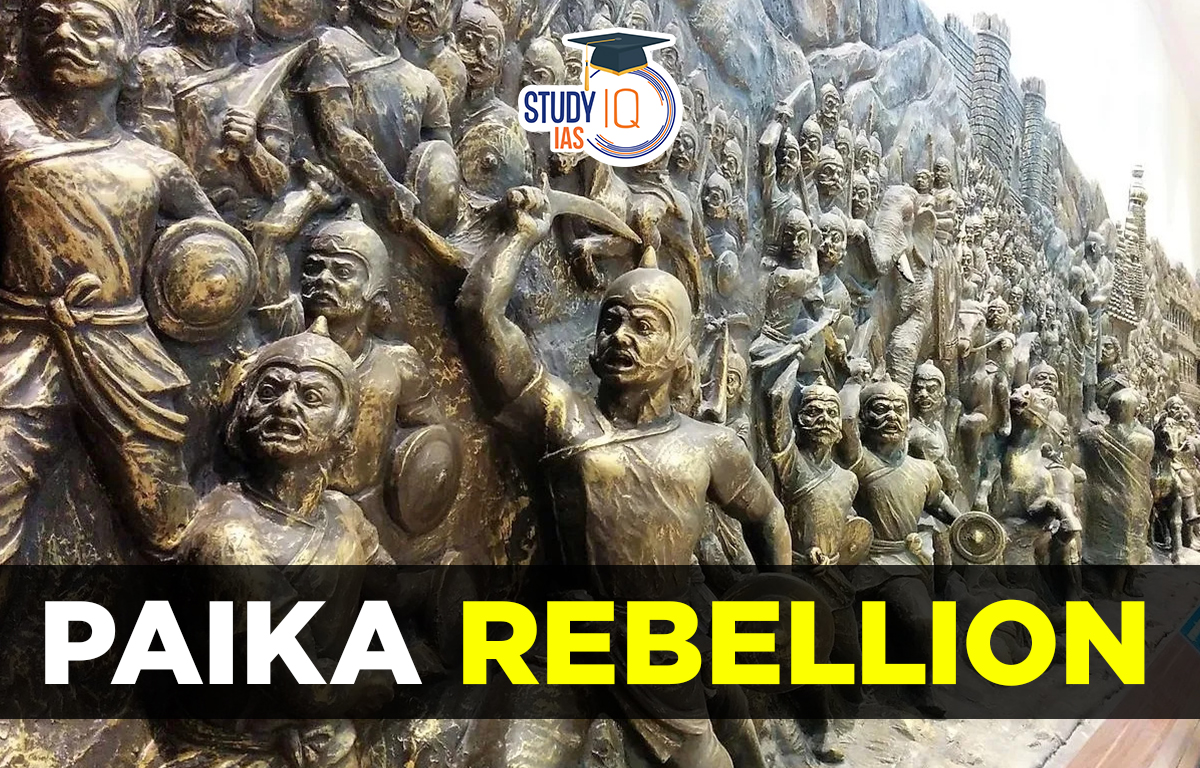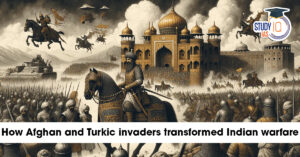Table of Contents
Context: Former Odisha CM Naveen Patnaik condemned the exclusion of the Paika Rebellion 1817 from NCERT’s new Class VIII history textbook, calling it a “huge dishonour,” while NCERT clarified it will be included in the upcoming second volume.
Paika Rebellion 1817
Paika Rebellion is also known as Paika Bidroha. India experienced an armed rebellion against Company rule in 1817. Bakshi Jagabandhu commanded the Paikas when they revolted, using Lord Jagannath as a stand-in for Odia unity. Before being put down by Company soldiers, the uprising quickly spread across much of Odisha. You will learn about the Paika Rebellion (1817) in this article, which will help you prepare for the UPSC Civil Service Exam.
- In March 1817, about 400 Kondhs from Ghumusar joined forces with Paikas.
- Led by Bakshi Jagabandhu Bidyadhar, ex-commander of Khurda, the rebels launched an armed uprising.
- Key events:
- Attacked the Banpur police station
- Burned government buildings
- Looted treasuries and killed British officials
- The rebellion spread across Odisha but was eventually crushed by the British.
- Jagabandhu evaded capture for years and surrendered in 1825 under negotiated terms.
The Paikas: Odisha’s Warrior Farmers
- The Paikas were traditional foot soldiers in Odisha, serving the Gajapati kings since the 16th century.
- In return for their military service, they were granted hereditary rent-free lands called nish-kar jagirs.
- British policies eroded these privileges, causing deep resentment and unrest.

Paika Rebellion History
Many social, economic, and political elements led to the Paika Rebellion. Four commercial ports in Odisha are part of vast regional networks that connect millions of traders. The East India Company alienated large segments of the local population by closing these ports to commerce in order to protect its monopolies. By taking away the ancestral rent-free lands that had been granted to the educated and wealthy natives, the Paikas, after the capture of Khurda, the East India Company administration infuriated them.
The Company’s management and slaves also utilised extortion against the Paikas. Both peasants and zamindars were negatively impacted by the Company’s coercive land revenue tactics. The rise in salt prices brought on by charges imposed by the Company administration greatly alarmed the general populace. Moreover, the East India Company abolished the cowrie money system that had existed in Odisha before its invasion and mandated the payment of all taxes in silver.
The general populace as a whole experienced considerable misery and discontent as a result. In 1804, the Paikas helped the Raja of Khurda prepare an uprising against the Company, but the conspiracy was discovered, and the Raja’s territory was captured.
Causes of Paika Rebellion
British Betrayal and Fall of Khurda (1803–1806)
- In 1803, British forces under Colonel Harcourt captured Puri and Cuttack.
- A deal was made with Mukunda Deva II of Khurda: ₹1 lakh and four parganas in exchange for cooperation.
- The British partially fulfilled the deal, giving ₹40,000 but withholding land.
- Jayee Rajguru, royal custodian, led 2,000 Paikas in protest but was arrested and executed in 1806.
- The British dethroned the king, demolished Barunei Fort, seized lands, and exiled the king to Puri.
Causes of Growing Resentment
- Loss of jagirs and royal support left Paikas economically vulnerable.
- British land revenue reforms displaced Odia landowners, favouring absentee Bengali landlords.
- The introduction of the silver rupee taxation burdened tribals and poor peasants.
- British control over the salt trade (since 1814) worsened rural distress, especially in hilly regions.
The King of Khurda, Mukunda Deva II, was enraged by the British administration’s quick introduction of a new system of governance after seizing control of Odisha from the Marathas in 1803. The British quickly learned of his planned uprising in cooperation with the Paikas and tore him to pieces. Then they seized all of the Paikas’ land under the inheritance of the overthrown King.
In addition, a number of other British actions, such as the implementation of a new monetary system, the abuse of the Paikas by company officials, and the prohibition on the production of salt from saltwater, sowed discontent and animosity against the British. A powerful contingent of 400 Khonds from Ghumusar marched to Khorda in 1817 and announced their intention to liberate both Ghumusar and Khorda from British domination. The Paikas of Khurda also joined the crowd.
Paika Rebellion Course of Events
While marching towards Khurda, the Paikas killed some East India Company officials and set a police station on fire. The kings of Nayagarh, Kujang, Kanika, village headmen, peasants, and zamindars all provided strong support for the uprising. Rapid expansion of the uprising into Purl, Pipli, Cuttack, and other areas of Odisha.
The Paikas first appeared to have the upper hand in the conflict and had some success, but they were put down by the British in just three months. Although some Paikas engaged in guerrilla warfare against the British, the uprising was put down completely by 1819. As a result, it persisted for a year and a half before being brutally put down by the armies of the British East India Company. The Paika leader, Bakshi Jagabandhu, surrendered to the British in 1825 after suffering several defeats, and he remained a prisoner at Cuttack till his death in 1829.
Paika Rebellion Outcome
The outcome of the Pika Rebellion was depressing since the rebels responsible received execution and lengthy prison terms. The British government created a panel to investigate the uprising. Following this Paika insurrection, which was started by residents of the Kandha and Koi regions, there were violent upheavals. The income policy, which remained unchanged after the Paika uprising, was the main problem.
Lord Jagannath was portrayed by the insurgents as the emblem of Odiya unity. This was a brutal uprising that took place before the renowned Rebellion of 1857, which challenged British Sovereignty in India, but it was not very well-liked. The Prime Minister honoured and recognised the descendants of families connected to the uprising on the occasion of the 200th anniversary of the rebellion.
Legacy and Modern Political Significance
- The Paika Rebellion is seen as a symbol of Odia pride and resistance.
- In 2017, Odisha demanded it be recognised as India’s first war of independence (decades before 1857).
- The Centre did not grant this recognition, but acknowledged it as a major early uprising.
- PM Modi honoured Paika descendants in 2017.
- President Ram Nath Kovind laid the foundation for a Paika Memorial in 2019.
- In 2021, the Union Culture Minister confirmed its inclusion in Class VIII textbooks.
Paika Rebellion UPSC
During the uprising, Lord Jagannath was represented as a symbol of Odia harmony. It was a terrible uprising that took place before the well-known Revolt of 1857, which challenged British Sovereignty in India, but it did not have popular support. On the 200th anniversary of the insurrection, the prime minister honoured and praised the offspring of families involved in it.
| Related Articles | |
| Sanyasi Revolt | Indigo Revolt |
| British Administration System | Socio-Religious Reform Movement |
| Singh Sabha Movement | Ahmadiyya Movement |


 Birsa Munda Birth Anniversary 2025: Life...
Birsa Munda Birth Anniversary 2025: Life...
 Military Innovations of Afghans and Turk...
Military Innovations of Afghans and Turk...
 Self-Respect Movement, History, Objectiv...
Self-Respect Movement, History, Objectiv...

























